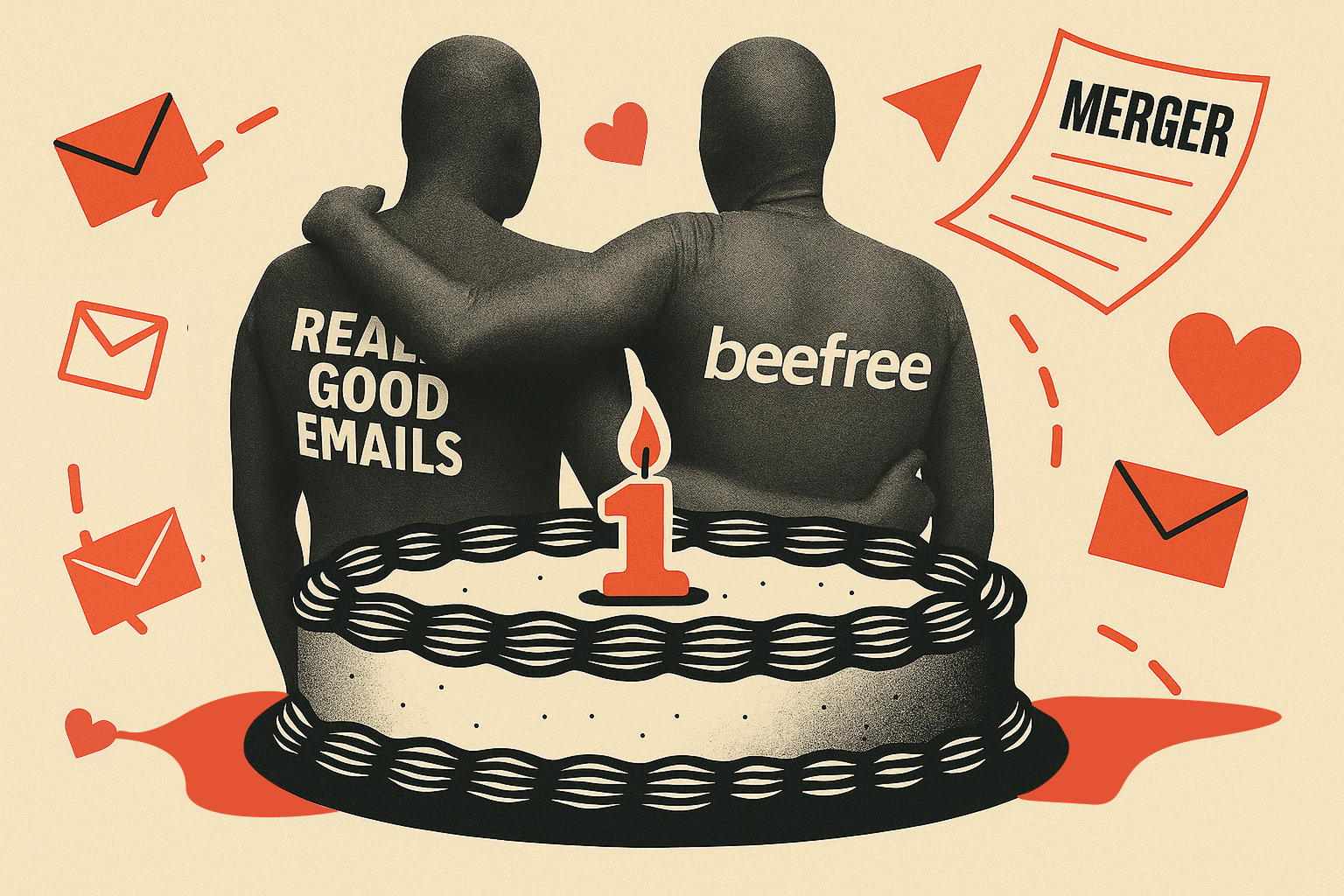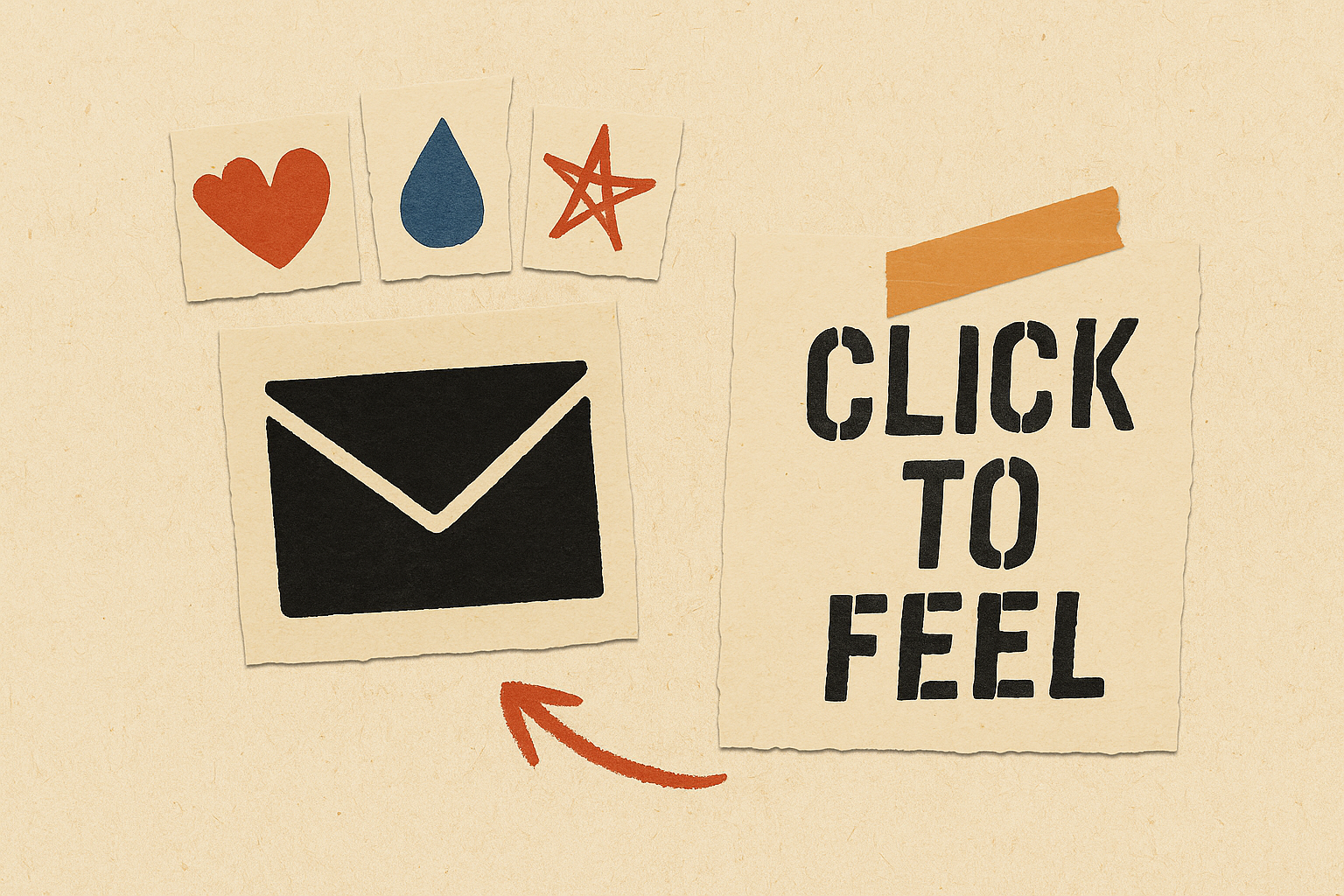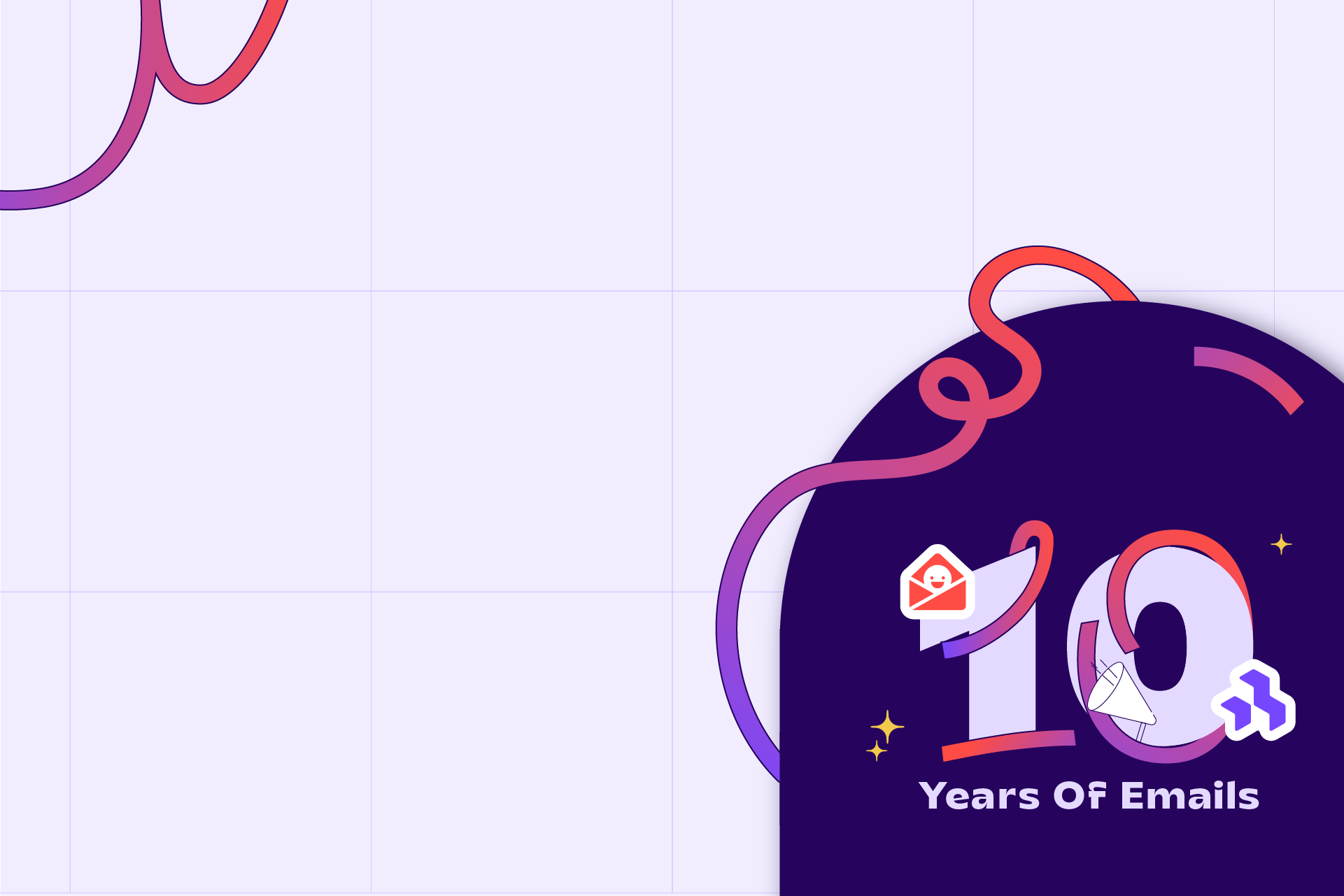Lianna Patch: Let's see what happened. Alright, we are going to talk about feelings. Feelings are so important. As you may know, I am an email person, but not a design email person. I mostly write plain text emails, so the words matter, you know. Yeah, I'm one plain-text person. Woo. Words. Thank you. Okay, so in this talk, I will show you six feelings that your users will experience. I think it says seven out there, but tariffs, you know. I will show you where those feelings live in the funnel: customer experience, journey, or whatever you want. And I'm going to show you what those feelings actually look like in copy, what they're doing in your readers' brains, and how you can use them to your advantage.
Sounds good? The whole point is to know, like, and trust, right? We want people to like us. I think it was Allison talking about North Star metrics yesterday, right? Usually, it's money. But it's also like, do they like me? Do, do they like me? You know? That's all I want. That's my North Star metric. Please like me. So, at the end of this talk, why do we have to do this? Oh my God, everyone is; I'm just a developer. Don't make me think about this because people who make decisions about email have feelings, too. They laugh, they cry, they eat. They poop. Poop. Everybody poops. And people who poop are buying software and products, right? Everybody poops. Anyway, that's what I want you to remember from this talk.
Everybody poops, and you're like, but hey, actually, it feels sort of disrespectful to our readers because they're B2B, and they only care about the facts. Let's just get it to their faces as soon as possible. Untrue. If you cut them, do they not bleed?
If you tickle them, do they not? Elmo. Are there any unbreakable Kimmy Schmidt fans? No. Okay. Thank you. Okay. I have a couple of disclaimers before we get in here. These are flexible guidelines. You know, we're soft in this arena, this area. You can use any feeling in your copy anywhere in the funnel. There's no hard and fast rule. There are just some guidelines that I'm going to give you. Second disclaimer. There are way more feelings than this. If you were on spam in 2020, maybe you saw a feelings wheel. There are so many feelings, and I know this because I have felt them all, all the time.
I cry constantly. I cried this morning because I couldn't get my contact lens in my eye. I figured the crying would help. Don't awe me. I'm an independent woman. Okay? Here's me at 10 years old. I was crying. It was a horseback ride. My mom was like, "Great time to take a picture." Years later, I was like, "Why did you take this photo?" She's like, I thought you looked cute. I was like, I was weeping. Why was I weeping? Because this motherfucker decided to run me at full speed under a tree, whacked me in the face with a branch. I was, yes, I was wearing a helmet. You could see it on the ground, but you know what? A helmet does not protect you from betrayal.
Fuck that horse. Just before we move on, I just want you to know I'm a sensitive girl. These are some real things that have made me cry recently. My boyfriend was coming back in eight hours. Falling off my bike still hurts. It was a month ago. I sprained my neck. Let's not talk about it. Yeah. So, looking this way, I'm like, be careful. What if it breaks? Okay. If I start this off with a pop quiz, will you participate? Yes, please. Hell yeah. Okay. Which of these pieces of copy makes you feel more feelings?
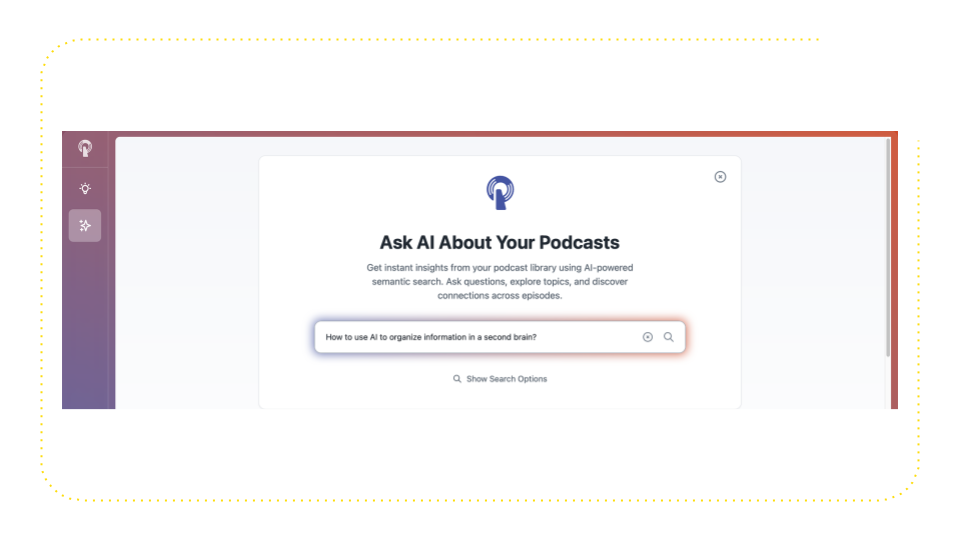
So we have Ask AI about your podcasts. Use AI-powered semantic search to get instant insights from your podcast library. Ask questions, explore topics, and discover connections across episodes. You got it.
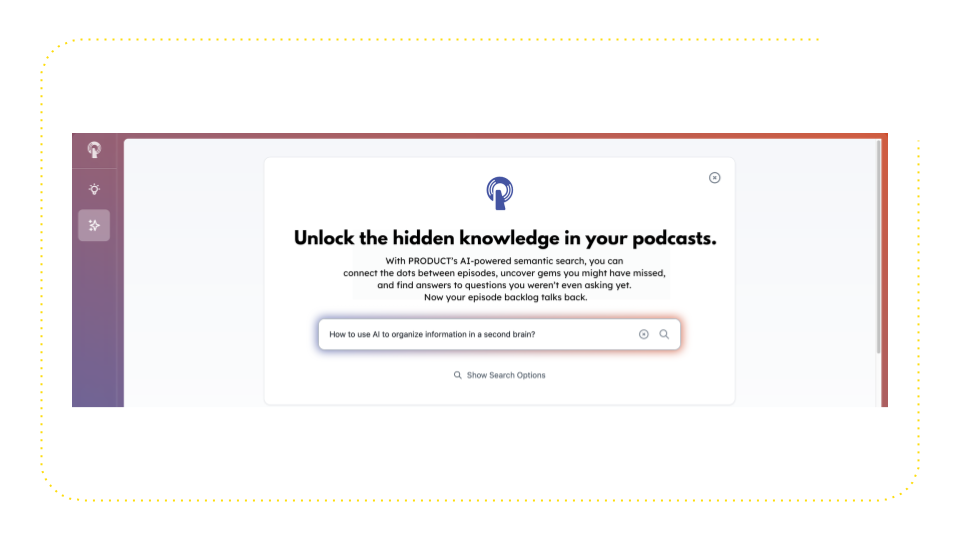
Version B unlocks the hidden knowledge in your podcasts with product names.
AI-powered semantic Search. You can connect the dots between episodes, uncover gems you might've missed, and find answers to questions you weren't even asking. Now your episode backlog talks back. Okay. Which makes you feel more feelings. We know the correct answer. Is it B? Yeah. Right. Okay. What feelings does it make you feel? Curiosity. I like that one. There is no correct answer, but curiosity is kind of going for it. Okay. Let's do it again.

Here's Monday CRM. We've all heard of it: “Track deals through the pipeline.” That's version A and version B. “Always know where every agreement stands.” Do we like it? The pressure is in this room. Can you imagine if one person was like, I feel feelings pipelines? Is it version B? Yes. And this is, funnily enough, the real Monday ad. I screenshotted it, and then I made a worse version of it. Hey Monday, call me. Okay? So, even if you are still not bought into using emotional copy, please do it for her.
Okay. She's been through enough, right? Yeah. They used to call me Little Miss Thundercloud. You can probably see why. Anyway, let's get into it. What's the first feeling we're gonna start with? And I feel like, Ann, you teed me up so perfectly for this. Cause, like, it all begins with the pain, right? It all starts with frustration, bad things, anger, fear, and disappointment. We have to start there. Why do we have to start there? Because you're not gonna do anything unless you have a problem. You may have heard, people don't buy vitamins. They buy painkillers, right? We don't act until we have a problem. Pain is our motivation. And there's nothing wrong with having a product or a service that's a vitamin, but you're still gonna use pain to sell it.
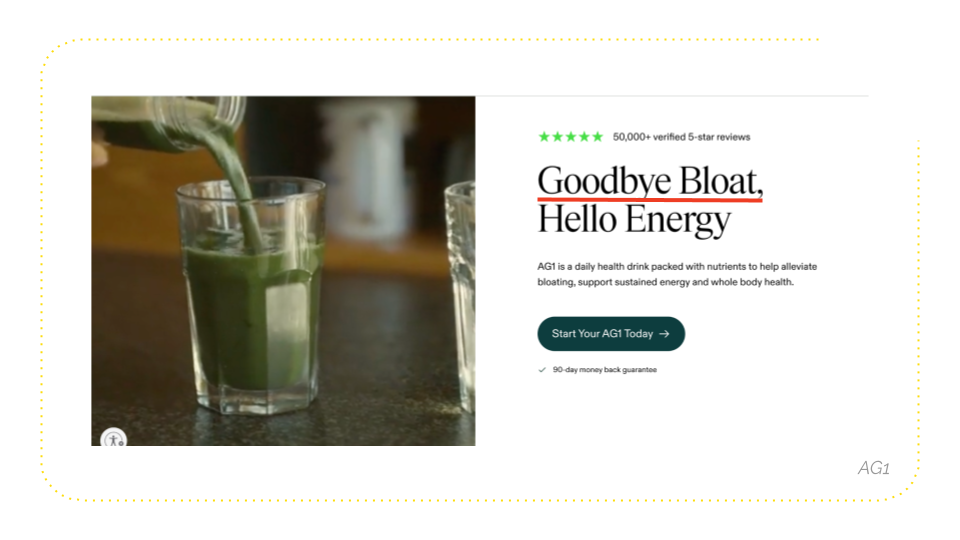
So here is a literal vitamin: AG1, Athletic Greens. They're doing a rebrand. Has anyone heard from AG1? Okay, so no one is to hear from them, and I could say, "I don't like that rebrand." It doesn't matter. Notice how they're selling benefits. Yes, they're selling a vitamin, but starting with pain. Goodbye bloat. And then the copy underneath it says, alleviate bloating, right? You can also notice the balance of pain, like promises and pain to benefit. It's probably about one part pain to two parts. Good things, right? We're not hitting it too hard. So, where do we want to use frustration throughout the funnel?
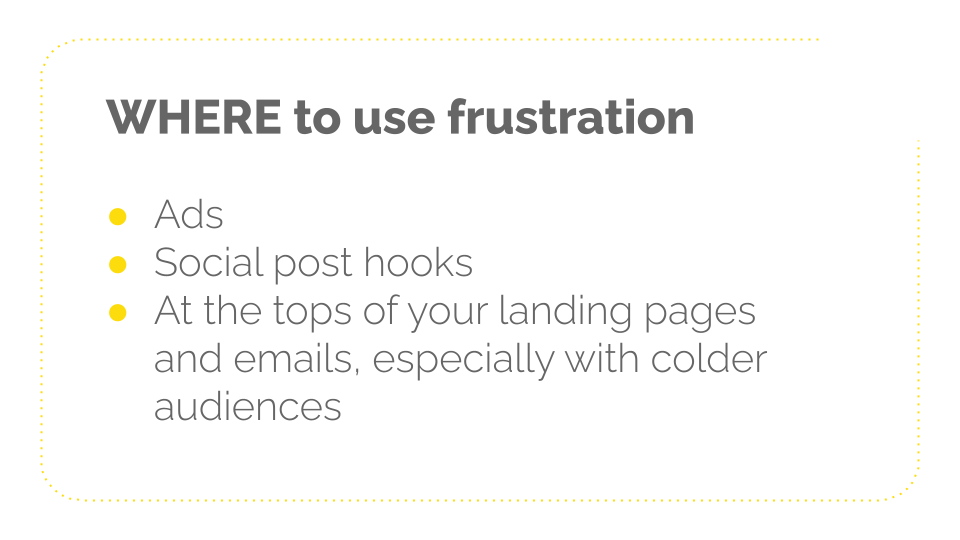
Please forgive me for talking about things other than emails. I know we like to pretend that emails are the only thing, but they're not. I write other stuff, too. So use it in your ads because it's something that's going to stop a scroll. Same with your social posts. Hooks. I love to open LinkedIn and see a post. That's like, I was having a problem. Yes. Tell me what it was. I want to experience Schadenfreude. And then at the tops of your landing pages and your emails, especially if you have newer subscribers or colder traffic, you want to show them that you understand their pain, right? You're like, yeah, we, we fucking get it.
We've been doing this. What does that look like in the copy, though? Pretty simple. It sucks. When this thing is happening to you, don't you hate it? When this thing is happening to you, are you tired of, are you sick of, are you done with? Hey, we're right here with you. We get your pain. So here are some examples.
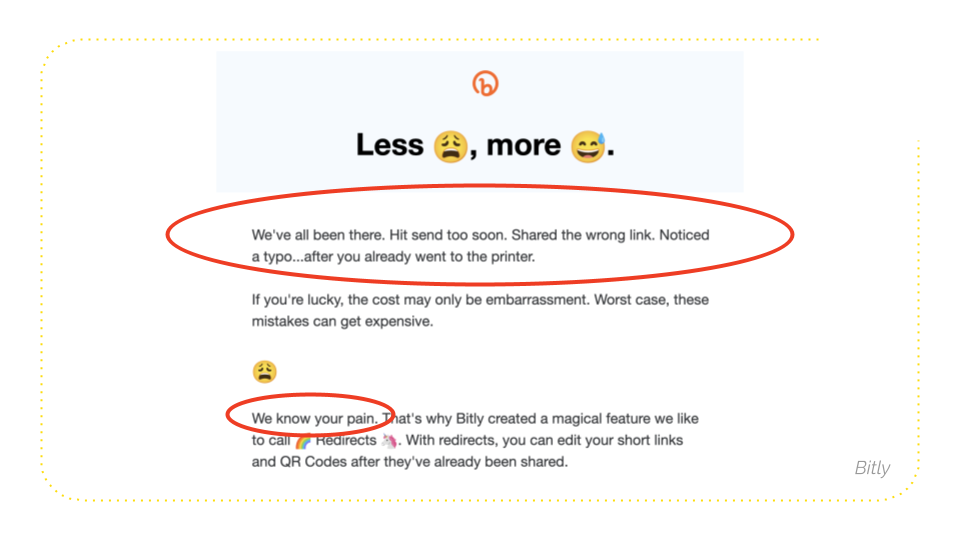
This is a Bitly. They say, we've all been there: hit send too soon, shared the wrong link, noticed the typo after you already went to the printer. And they say we know your pain. Which is like, if they could do it, we could do it right. I do want to also point out that with this example, they're saying, we've been there. We know your pain. You have to be very careful when you're talking about knowing someone's pain not to instigate what I call the “we” problem. It's too much about us; it's not enough about you. You don't know. We are all over your readers unless you're into that. Please do not talk to me. Wash your hands.

This is my client map pastry, prevent permit violations. At the end of the paragraph, we talk about the pain, right? We remind them, "Hey, why are we selling you this?" If you want to see the whole page, it is extremely unhinged. It's at retire spreadsheets.com. Do not blame me for the design. They did allow me to write my favorite call to action of all time, which was, “operators are standing by to take your spreadsheets out behind the barn”. It's so dark, so dark, and who knows if they're still sending traffic.
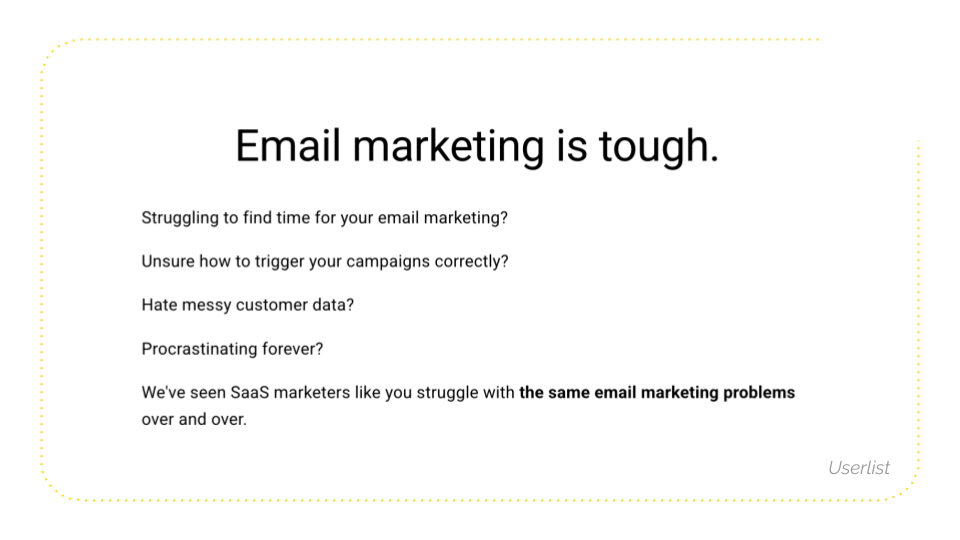
Here is the Userlist, an email marketing tool for SaaS companies. This tool discusses email marketing, and I'm discussing it at an email marketing conference.
We're in the simulation. They say, are you struggling to find time? Are you unsure how to trigger your campaigns correctly? Do you hate messy customer data? All these separate pains, which, if you are gathering voice of customer data and translating features into benefits, you already know that they have all these problems.
You can just list them out, right? We should be doing this. You're like, “but I don't wanna make people feel bad”, right? “My readers are more intelligent than this. They already know they have a problem. We are not trying to make them feel so bad”. You may be conflating this idea of pain with a classic direct response copy where it's like, “Hey, you piece of shit”. If you don't buy this thing, you are a worse person. And you're like, “oh my God, I just clicked on a link, and all of a sudden, I feel terrible about myself”. We're not doing that, right? And part of the reason we're not doing that is that we are not making them feel bad about something they can't change.
This is the glory of email. All they have to do is click. It's so easy for a baby to do it. I have a lot of babies on my list. I don't know why I said that. I really hope not. My God. Okay. Are we set on pain? Do we understand the importance of pain? Yes. Yes. Okay, cool. Feeling number two is skepticism, and immediately, you're like. I feel skeptical about this. Why is this particular feeling following pain as a broader feeling? Because it's so important, right? We're trying to meet the readers where they are. Most of the time, they say, "I don't believe you. I've been lied to before." They are feeling it. We have to meet them where they are, especially if they are more educated and a little more jaded.
Marketers, we've seen it all, right? We know what's coming after the initial, like LinkedIn cold DM, like, “Hey, Leanna, how's business?” or “I don't want it, Marco. I don't know what you're going to sell me, but I don't want it.” Okay. Where do we use skepticism? Anytime in your copy, your reader could legitimately be like, “Sure.”

But anytime they're like. “I don't trust that claim”. If you're writing competitor comparison pages, which you should be, and they should be linked in the footer of your site. I don't care what your product is, it should still be there. If you're doing a parenthetical aside, which is the sort of copy equivalent of whispering into your reader's ear. Sometimes, that's where you make a joke, right? We're taking a break from the serious stuff and whispering. And if you have any value-driven or educational emails, which you do in your lifecycle flows and sales emails, right? All in service of meeting people where they are, showing we understand them, and what does that look like?
We know this is what you're probably thinking, and we can address skepticism by pointing out explicitly what they don't want while promising them what they do want. So, get the thing you wish to without the thing you hate or the thing you're trying to escape. So without, and even if. So, they're sure, but I'm having this other problem. That always happens when I use your competition tool, and you're like, “haha. Yes. Even if you're doing this thing, you can do it better with our thing”. It's so vague. I know. Let me show you what it looks like.
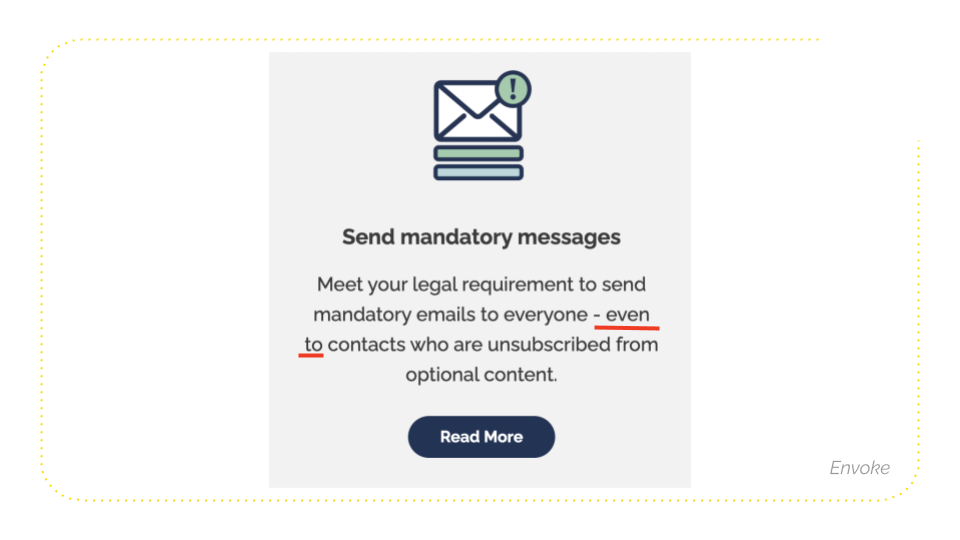
Here is Envoke, an email marketing platform. Again, there are so many, and they say send mandatory messages.
“Meet your legal requirement to send mandatory emails even to unsubscribed contacts”. Huge pain point, right? People are skeptical of trying a new solution because they've tried it before and figured out they couldn't still send emails to mandatory messaging lists, right? Invoke knows this, and they're talking about it, and they're copying.
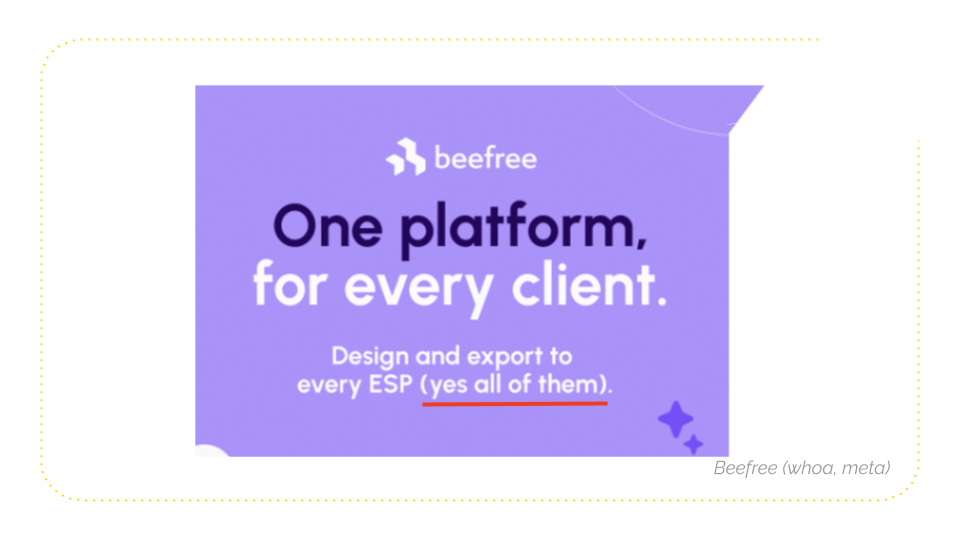
Oh my God, is that Beefree?. How did that get in there? Who put that in there? I love this parenthetical aside because it's like design and export to every ESP, and you're like, oh yeah, well, I use twinkle Fuck, and nobody exports to that. And you're like, yes. We also do it when they warn you. Some speakers will swear they're talking about me. I'm sorry. I'm glad my mom's not here. She was two days ago. They live here. It's weird.
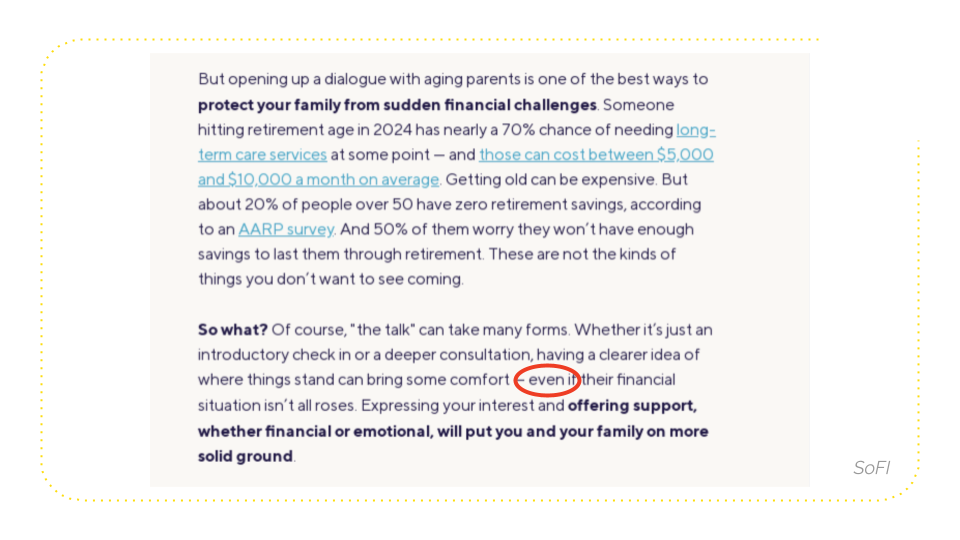
Here is SoFi doing the even-if thing, and I just put this here. It doesn't matter what they're talking about. I just put this here to show you that if a bank can address skepticism like this, so can you. Right. Nobody's. Does anybody here work for SoFi? Great. It's a little moment for self-reflection. Next time you are deep in the guts of your emails, look out for these phrases in your copy. Look out for without, look out for actually, look out for even if, look out for any opportunity for a parenthetical aside.
One way to do this is if you read your emails out loud. You can hear them as your customer or your reader may listen to them, and you can hear the parts where they could reasonably say. I don't. I don't think so. That's where you should add some addressing, some addressing of skepticism, right? Those are not words, but you know what I mean. Do you have them? Probably not, right? But these are easy ways to make your emails more conversational and emotional. I. Okay. The third feeling is hope, which is everyone's favorite new emoji. This filled a gap in my emoji library. Yes. Okay. Hope is what everyone wants, right? Like hope floats.
Hope is the thing with feathers. You know, people write poetry about hope. They don't write poetry about transactional emails. Most of the time, if you do, please talk to me. I would love to read it. We want to use hope to tweak people's attention slightly. Like, hey, things can be different and better, according to my therapist. I don't know if I believe her. And we're gonna use it as an on-ramp to excitement. I'll explain the difference between hope and excitement in a second. We'll use it as an on-ramp to excitement because otherwise, things get a little weird and fake feeling, and we don't wanna be fake.
So, what does hope look like in copy? We're painting the picture of their perfect future. We're just helping them turn on the part of their brain that daydreams a little bit. Like, "Hey, imagine if you could do this." A classic piece of copy is you'll love. I know it seems a little played out, but it still works. Even if we don't believe them. Skepticism, right? We are forced to imagine loving what we are told we'll love. And wouldn't it be awesome? Just push them into the dream state a little bit. And where do we wanna do this?
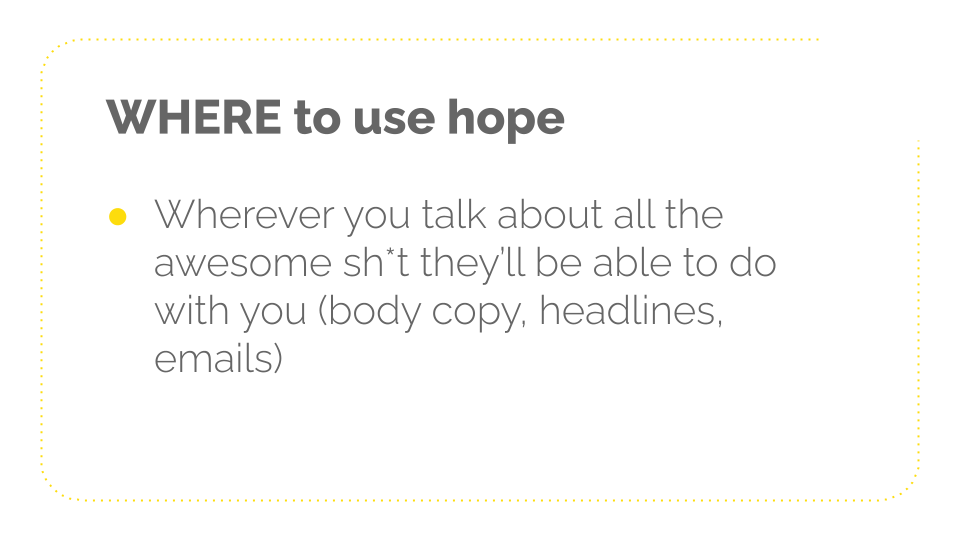
Whenever you are talking about all of the awesome shit they'll be able to do, in your body copy, in your headlines, in your emails, and not quite in your CTAs.
Because we're gonna do something else different there. So, what does hope look like?
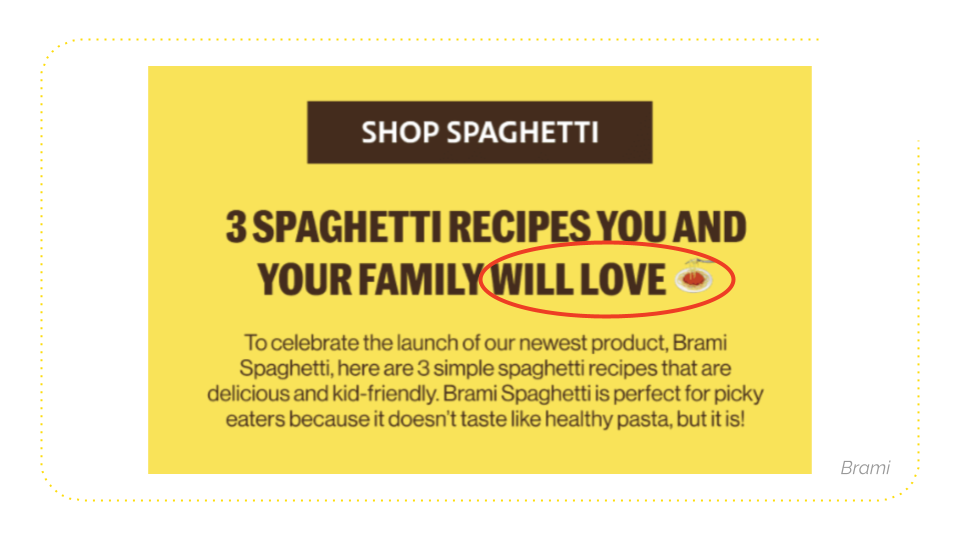
I think this company is Brami, but there's also a tank top company called Bray, and they keep targeting me on Instagram. They're like, you don't need a real bra, you should wear this tank top. And I'm like, that's rude and accurate. Thanks a lot. So, “recipes your family will love”. Your stupid kid hates all food. Try this. We promise he'll like it.
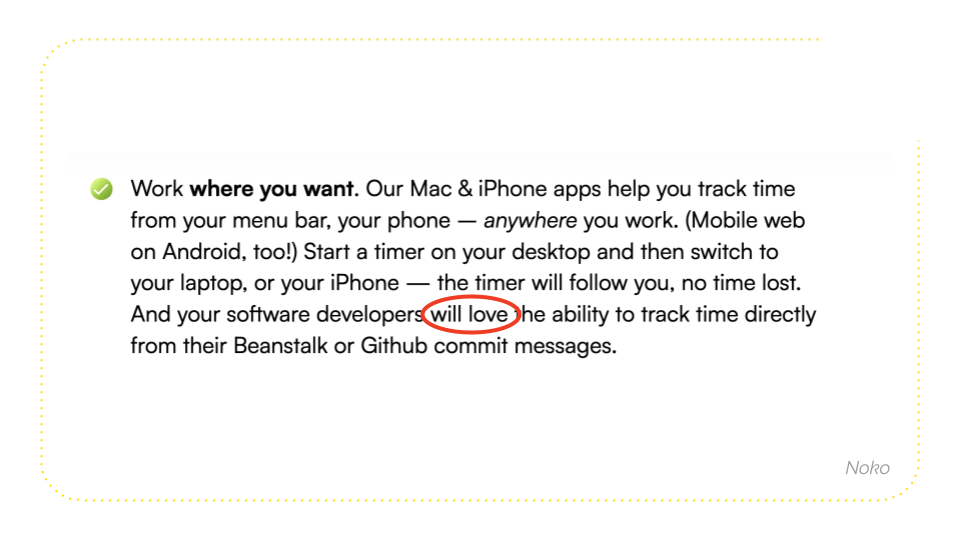
Here is Noko, a time-tracking tool. They say your software developers will love the ability to track time directly. We're not sure about this because software developers love to hate things, but maybe they will. Who knows? It's accurate, and it's an enticing enough promise. Right. Okay. Back to your copy. No one likes it so late in the day. Nobody has their emails open, but if you were to rip into your emails right now with absolutely no oversight, could you? Look out for moments of hope in your copy, especially in onboarding and nurturing flows.
How are we showing people that they have something to look forward to? And yeah, hope is like the flip side of pain. If you don't have hope and you only have pain, people are going to get really turned off and unsubscribe. Right? Nobody wants to read an email every week that's like, man, this sucks. Okay, bye. Those are the emails that I write.
On to the next, excitement—my favorite feeling. I've vacillated wildly between excitement and anxiety. If I'm not crying, I'm excited. Sometimes, I'm excited and crying, which I could do now. That's my party trick, but I won't. What is the difference, you may ask, between excitement and hope? I just mentioned that I would tell you this. Hope is the on-ramp, right? With hope, we're waiting for the remarkable thing to happen. We're waiting for them to take action. This is preceding the cool thing that's happening. With excitement, the cool thing is happening right now, or it's just happened.
Does that make sense? We're celebrating the thing that is happening. Cool. It's a subtle distinction. Why do we use this? We want to get readers amped up so that they do what we want them to do. I love the way you describe getting users to take action in an email. I think it was you, Allison. It's like, it's what they should do. It's what is good for them. We know what's good for them. Fucking click the button. Click it. I need this. Anyway. And then we wanna reaffirm that they've made the right choice after they choose, because that's the moment when they might regret things, right? I had somebody ask for a refund on a course recently, and I was like, did I not excite you enough? She is nuts. It's fine. It's her, not me. And if we are not excited about a thing, why would they be excited? We're supposed to be the champions of our product or service. And if we're like, welcome, you made it here, log in, buy a thing, the order is coming, the order is on its way.
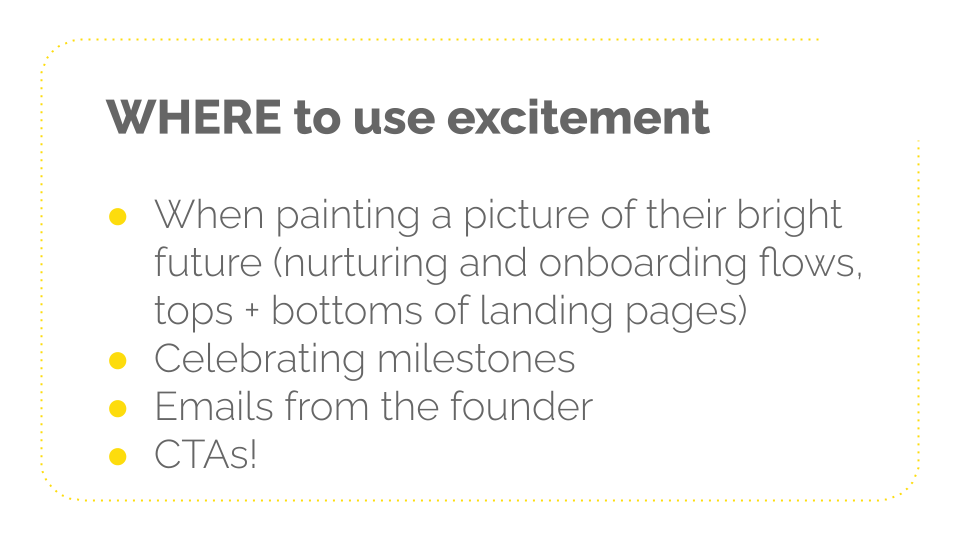
They're like, what the fuck am I doing here? I could spend my money anywhere else. Right? So, where do we want to use excitement? Again, we're painting a picture of their bright future. And once they've joined, they've taken action. They've joined our email list. We're like, hell yeah, you made it. You're here. Anytime they complete a milestone, if you're sending milestone-based lifecycle emails, which, like, who is? Raise your hand if you're, yeah. Hire, please. It's hard to see. Okay. So many people. Yeah. Milestone-based engagement emails. We love those. No other audience I've ever talked to is like, we're doing that.
They're like, you know. Do you mean the thing that I open in Outlook anytime you email from the founder? Naomi talked about text-based emails. I love a good text-based email from one person. I recently sent one for a new retainer client and made the sender address me. And so today, I got to go through many replies, like unsubscribe. I was like, the button's right there. It's at the bottom of the email. How have you survived this long without knowing where the fucking unsubscribe button is? Anyway, I was very nice. And finally, in CTAs. This is the pivotal moment. We've made them anxious and painful enough so that they're ready to take action.
We're driving them toward the CTA, the button, or the link. We should be excited there, right? What does it look like? Finally, now you can do this thing. You are about to get this thing. Give me the thing. That's a great call to action. I love that. Congrats on making this totally rad choice, and now make cool things happen.
Now again, with that Retire Spreadsheets landing page that I worked on, I think one of the buttons was to press the button, kill spreadsheet. Every time. Yeah. Every time you press this, God kills a spreadsheet. And like, you did it. So, do you have any of this in your copy? Are we getting excited? Somebody's like, yes. Hey, what does excitement not look like? Yes, I'm attacking you personally. “Request a demo”. “Learn more”. I've never in my life wanted to learn more. Not gonna start now. There is just so much friction in these calls to action, right? Why request a demo when we could say, book a quick or friendly one?
And if we're saying book a demo, we might as well say, book a demo with Jake. Hey, here's Jake's face. Hey, how long is it gonna take? Hey, is Jake gonna hard pitch me or not? How much more context can we give to the CTA to make it easier for them to click? Because they know what's on the other side, right? So many of these are Shop Now CTAs, and you're just like, okay, good luck. Just roll the dice. And then they send you to the homepage, and you're like, fuck, why am I even here? I was trying to buy something from Instagram, and they sent me to the whole page.
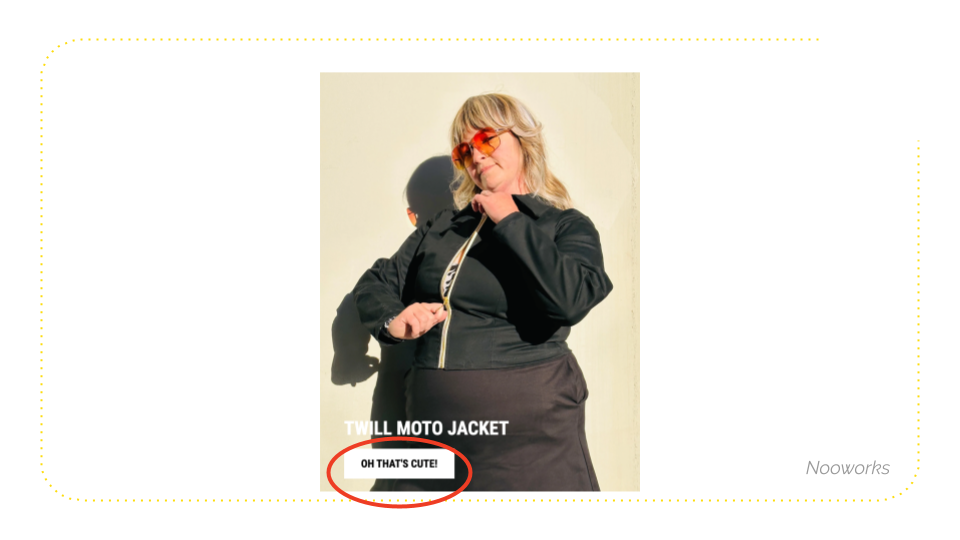
Here is a very cute CTA that I love. It's immediately there in the conversation I'm having with this image, like, oh, that's cute. That's what I'm thinking. There's no friction there. I don't have to apply myself to this button at all. Improve retention now. I love that.
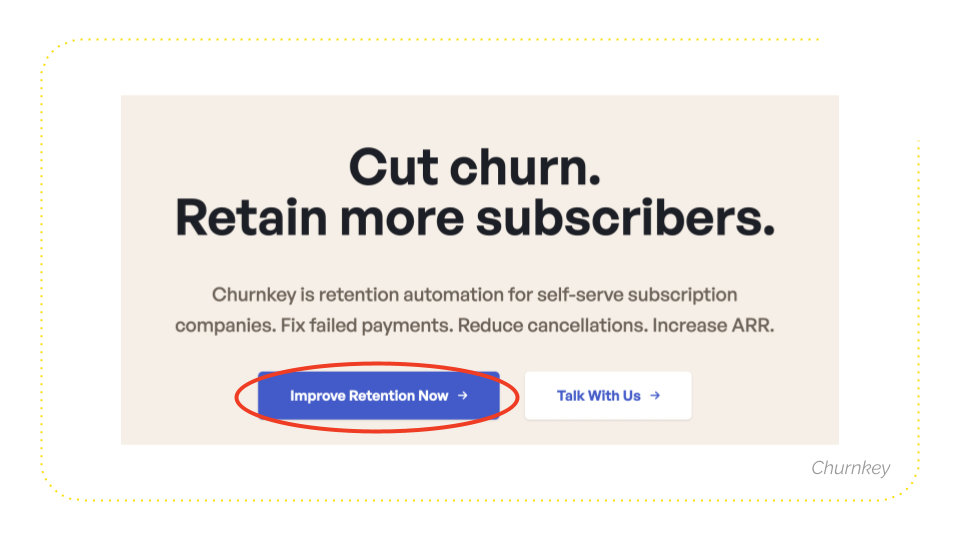
This is what we call a call to value, not a call to action. A call to action is what you do, which would be like starting a free trial. A call to value is what I get. What is the outcome of clicking this button? Go through your emails. See where to test a call to value versus a call to action. Maybe that would improve some clickthroughs. Who's to say? Certainly not me.
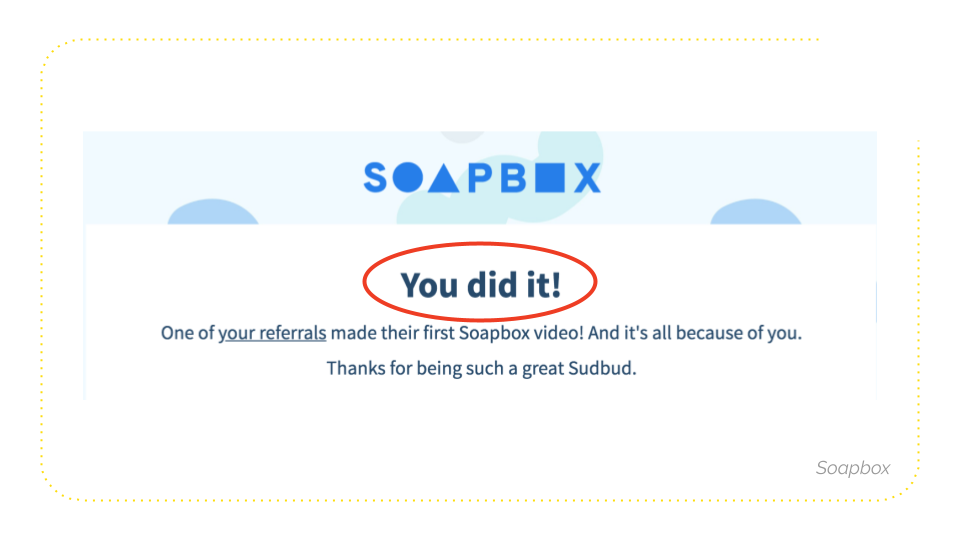
Here’s Soapbox, which is, I think, a now deprecated tool from Wistia. Does anybody know if Soapbox still exists? No? Okay. They’re like, hey, you did it. They sent this to me and said one of your referrals used the tool. And I'm like, it’s weird that you’re congratulating me for spying on my friends, but thanks, I guess. It’s very exciting. And they had a little gif of everybody who worked at Soapbox going like, yay.
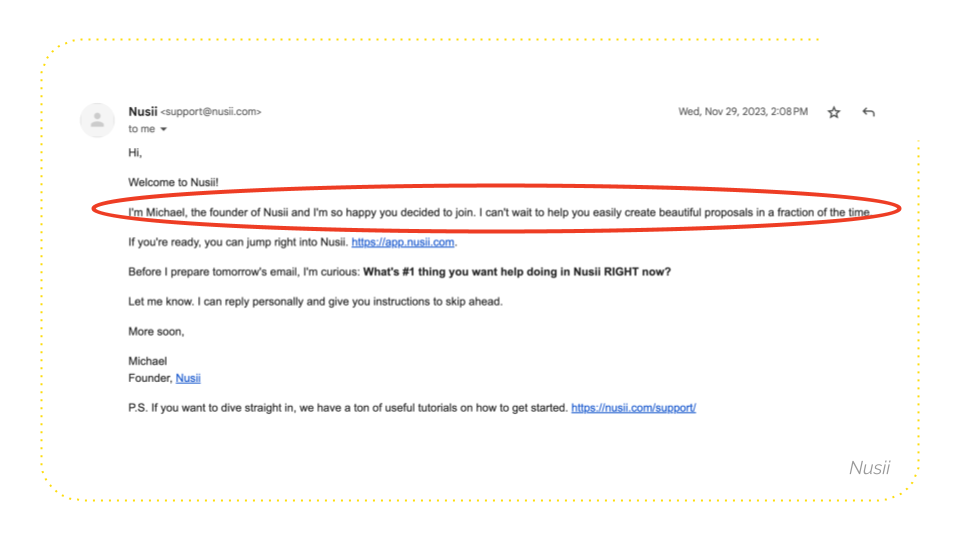
More of that. Here is an email after I signed up for a proposal tool. They say, I'm Michael, the founder, and I'm so happy you decided to join. I can't wait to help you easily create beautiful proposals in a fraction of the time. I love this for two reasons. It's from the founder, and he's pleased and reiterating what I signed up for—the correct value prop right there in the first sentence of the email, in case I happen to sustain head trauma in the 10 seconds between signing up and opening the email.
If somebody's like, or a horse returned, the horse haunts me.
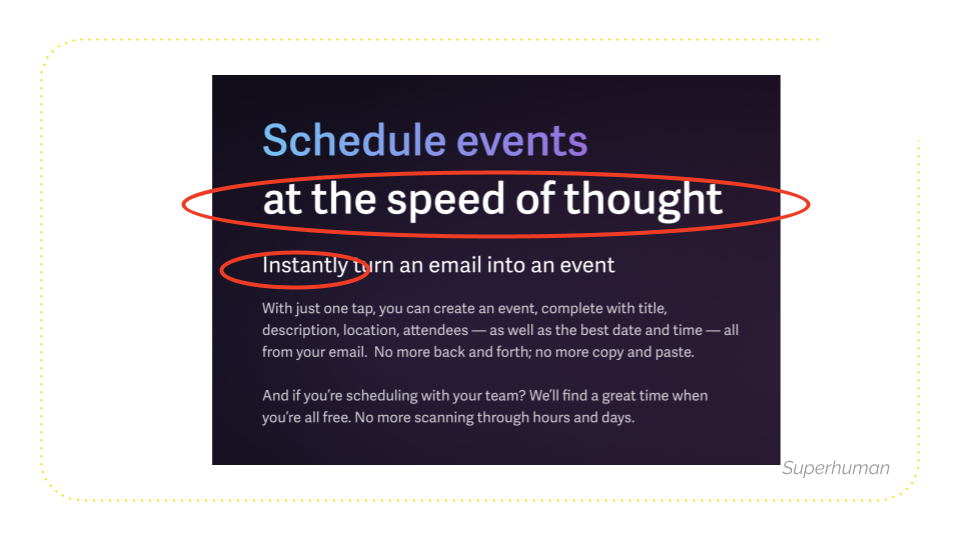
Okay. You know what else is exciting? Speed. These are Superhuman: schedule events at the speed of thought. It's a little douchey, but we get it. Instantly turn an email into an event. We all love to save time. We all love the idea of saving time.
It is fast and easy and doesn't cost us anything. The way to do this is by being very specific about how much time we will save, right? So instantly is very easy to imagine. Speed of thought, maybe not so much.
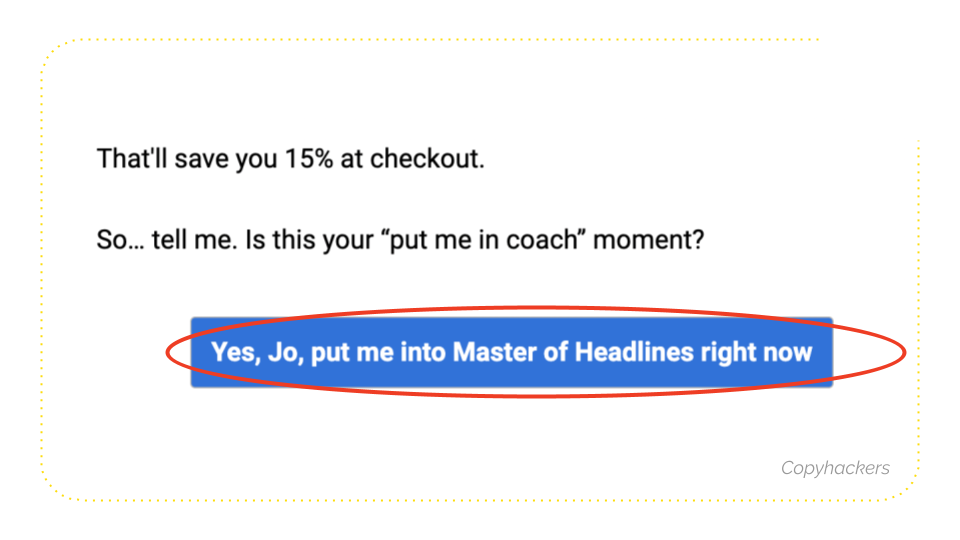
But here's right now. Does anybody have right now on their calls to action? Hmm. Bueller? Yeah. Okay. This is one of my first mentors. This is a program email for a sales email for one of her programs. And the call to action button: joins the conversation in your head. Yes, Jo, put me into Master of Headlines right now. And another reason I love this CTA is that it's long as fuck.
You cannot miss this button from space. It’s so easy to click.

Here is what it looks like when you do not use hope as an on-ramp to excitement. So this is from dear friends of mine and my new retainer clients, MicroCon. Surely they won't mind me making fun of them in a room of strangers. It says, "We value your interest in joining our community and look forward to having you." If you have any questions or concerns, please don't hesitate to contact us. And then the sign-off is inexplicable: Keep rocking it. It's like, were you kidnapped in between those lines? Who is this? Incongruous. Very weird.
So, just a tip for a second, just to see how it feels. A little excitement. You're like, this is a business conference. How dare you. I'm sorry. I can't help it. It is congenital and terminal. And then I just die. Wouldn't that be amazing? A little bit goes a long way, especially if you have a more buttoned-up brand. If you are very B2B, if it's very enterprisey out there, and you know that you can't just turn the dial to 11 and go keep rocking it.
Just pepper in a bit of excitement here or there. Try it in a subject line. Try it in body copy. Try it in a parenthetical aside. They work for everything. Try it, and then tell me how it goes.
Okay. Feeling number five: flattery.
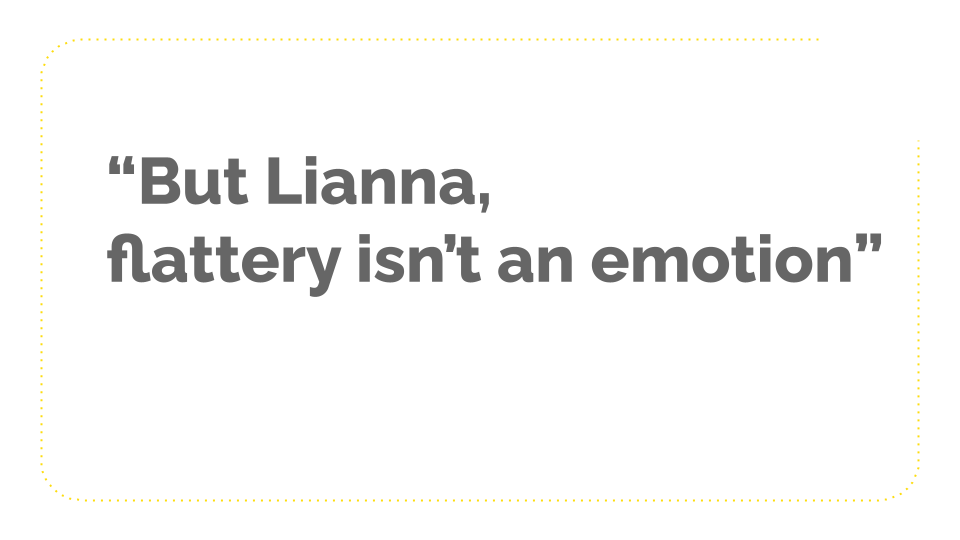
Okay. Feeling number five: flattery. Correctly, you are thinking this, and you might be right. But this is my talk, so I'm going to tell you about flattery because it's so important. It's such a key part of copy. And because the people in this room are the only people I ever get to hang out with who segment their lists so carefully, they have specific knowledge about each segment that you can use to flatter them.
People like feeling smart. They enjoy feeling on top of their shit. They need to be made to feel this way so that they don't just unsubscribe. Flattery is a potent tool to keep people on your list because if you make them feel good when they open an email, they will stick around.
So let's make them feel good, shall we? Where do we use it? Oh my God. Cold emails. I'm so sorry. You can pelt me with things now. I know we hate cold emails. She is a witch. Is nobody in here running a cold email program? Anyone? No? Okay. We'll look at that briefly.

But really, anytime you name who you're talking to — and again, if you are sending segmented emails, you are doing that — anytime you name their role, position, responsibilities, experience, background, and what they want, you can flatter them a little bit.
And what does that look like? You're not stupid. And that is a compliment. It's a little bit of a backward one. Yeah. It's like pulled straight from the incel playbook. You are not stupid. Not everyone cares or even knows the difference between particular distinctions they make in your industry, but you do. As an experienced person, whatever you are, you already know this thing. So you're meeting them. Come up here to my ivory tower. We're going to discuss that. The kids can't hear.

Here is Wise, formerly TransferWise, saying, you do business in multiple currencies, so you get it. And I'm like, oh yeah, I do business in multiple currencies all the time. CAD and USD. And that’s it. But thank you. I would love to be a multinational corporation sending money all over the planet.
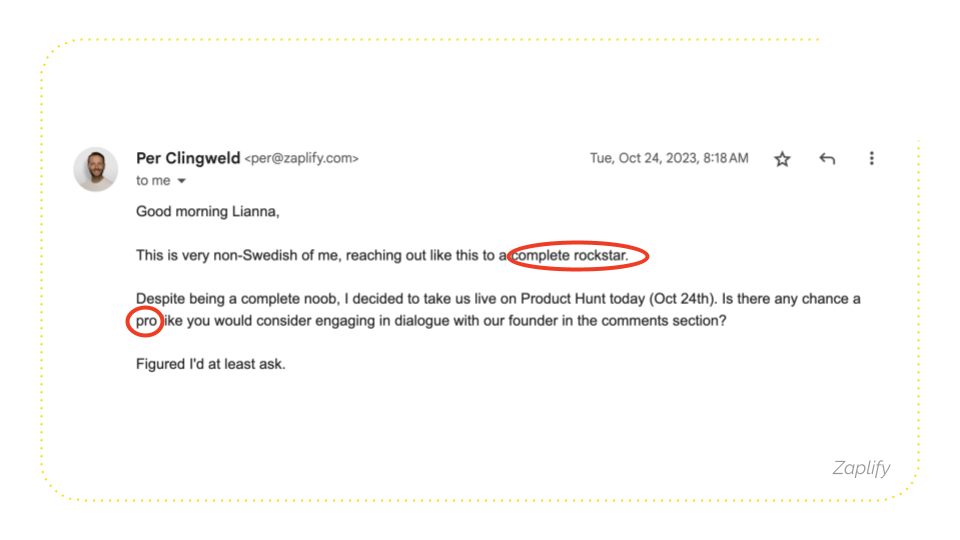
Here is a cold email I got a few years ago, and I have kept it all this time because so many of them are so bad, and this one was kind of good. He says, “Good morning, Leanna. It is very nonsensical of me to reach out like this to a complete rockstar.
Despite being a complete noob, I decided to take us live on Product Hunt today. Is there any chance a pro like you will consider engaging in dialogue with our founder in the comments section?”. And I was like, “when did you hear about me?” I also want to point out that he's being self-deprecating. Just a scooch, right? There's the charm-and-disarm method hard at work here. If you want to talk about using humor to make people comfortable, speak to me after this because I have a lot to say. But this worked. It was a little over the top. It still got a reply. I wrote back, and I was fine. You're welcome.
So where in your copy can you add a smack of ham? By which I mean flattery. Arrested Development? No? It's so watery, but with a smack of ham. I call it hot ham water.
Where can you help your readers see themselves in the copy, making them feel like, they know me. That's incredible. I should stick around. All readers speaking like that. Good. Everyone. Everyone not in this room. Oh, emails. You're not doing cold outreach, but if you were, you would add it there, correct? Yes? Okay.
The sixth and final feeling is confidence. This is a feeling we feel and pass on to the reader. It's much like excitement. We have to be excited to get them excited. We have to be confident to make them confident. Yes, I just said that. We need to show that we believe in what we're doing. Otherwise, why would they hang out with us? Why would they buy from us, keep reading our emails, like us, as we know? That's my North Star. And what does confidence look like in copy? Often, it's short, decisive statements. I feel like somebody long ago told copywriters that people will keep reading until there's a period. So just cram everything you can into one sentence, and it's like, no. I don't want to have to have a PhD to understand what you're trying to tell me in the first line of this email.
Use short sentences. Bold and specific claims — hopefully ones only you can make. Clear calls to action. We know what's going to happen on the other side, and we've already talked about that. And FAQs, because it shows that you have thought enough about their questions to answer them. And my favorite FAQ is the one at the bottom that says, “Hey, did we miss something?” It might seem insecure, but it's actually so secure. It's like, we know exactly who we are. Do you have any other questions? We're happy to answer them, and we'll add them to the FAQ afterward.
Also, if you're not sending an FAQ-specific email somewhere in your lifecycle emails, you should do that. Okay? I won't sing anymore.
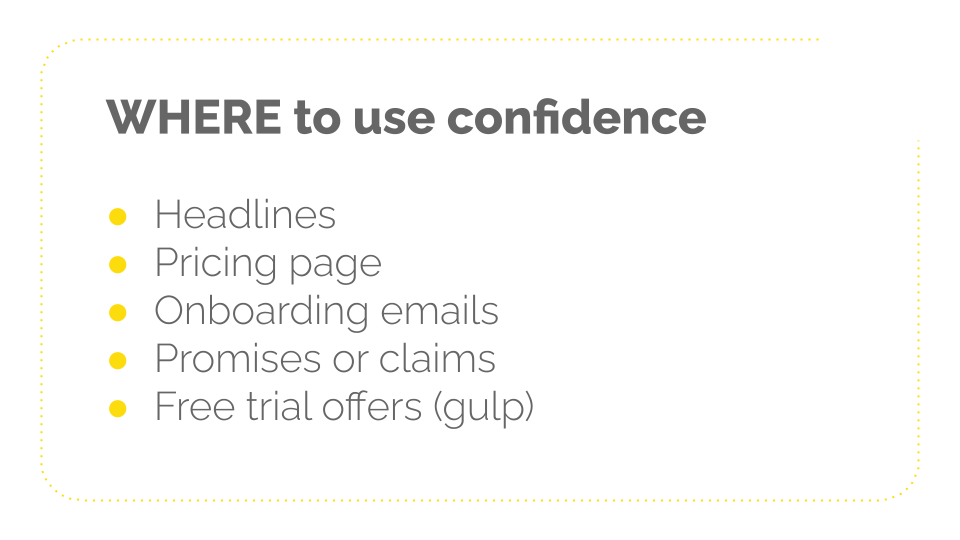
Where do we use confidence? In our headlines. On pricing pages. If any of you get to touch those, and if you can't, please pass this on to the person responsible for your pricing page. It's not legally required to have the word "pricing" in the headline. No one's going to be confused if it doesn't just say “Plans and Pricing.” It can say something totally different, and people will still know that this is where they buy it.
Onboarding emails. You absolutely want to be confident in your onboarding emails because this is your chance. Especially free trial to paid conversions, if you sell a software product. Welcome flow, if you're trying to get them to buy a physical product.
Be confident. We want to know you can back up any promises or claims you make. We talked about free trial offers.

What does confidence look like? Here's Superhuman again. “Save four hours per person every single week.” So, saving four hours per person is the promise. “Every single week” is the confidence. And then they're like, “We’re the most productive email app ever made.” Get some. That’s how I read that.
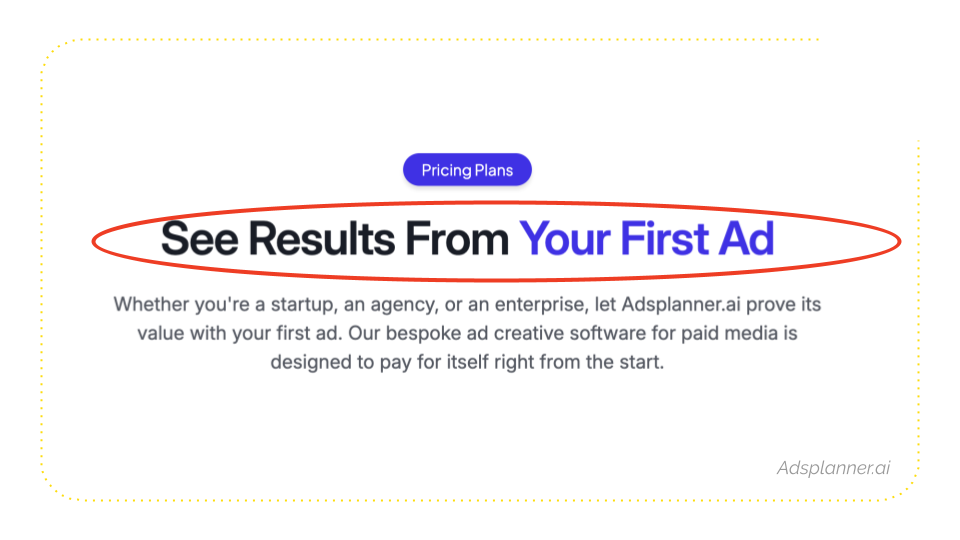
Here's another software saying, “See results from your first ad.” If you can say something like this, your reader will say, “Oh yeah? Bet. Let’s go.” I'm going to try it. As long as you can keep this promise on the other side — which you probably can — everyone here works for cool companies with a good product. We're going to want to take you up on that bet.
Confidence also looks like social proof. Trust signals. What are those? I'm just kidding. Why do we like social proof? We want to know that we are not alone, that we're not the first, and that there's not so much risk. To illustrate what social proof can look like, I have put a very real testimonial on this slide.

So, what does social proof look like? You might be thinking of reviews. Yes. Reviews and testimonials. I will show you one example, and then I'll give you a giant list. Here is Bench Accounting. They say 25,000 American small business owners trust them. So we have a twofer. There are 25,000 people just like me who are using this tool. And they're small business owners. I see myself reflected.
They abruptly declared bankruptcy in December, and then everyone was freaked out. So don't run your business like Bench, but do write your copy like Bench. Other examples are not just reviews and testimonials. Case studies. Certifications. Logos. Press coverage. Guarantees. Any numbers. Hard and fast numbers. If you need help making a number look impressive, ask a copywriter. We will work that number to death. Spelling it all out. Bolding it. Calling attention to it in the design. Is it five? Who cares about the number. The five is a big recap.
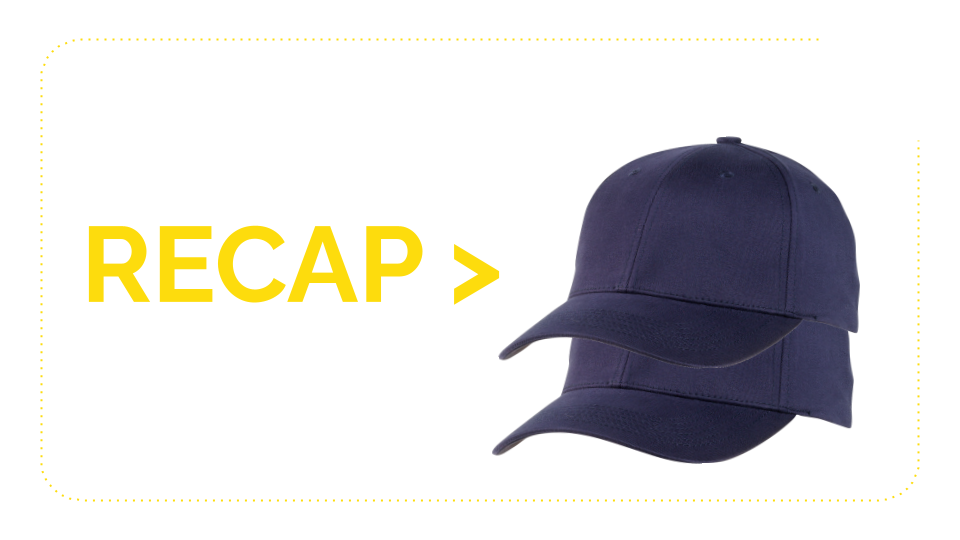
My best friend made my slides, and I was like, hey Julia, what if we had two ball caps for the recap? She was like, that’s stupid. I don’t think we should do that. I was like, you work for me. Do it. And she did it. Yeah. So I win.
TLDR. You do have to use a little bit of pain and anxiety. You do not have to overplay it. You do not have to make people feel evil about themselves.
If you want to use a little bit of excitement, make sure you're leading into it with a little hope. And if you want them to be excited, then you have to be excited yourself. Please do not fake it. Be excited about something. Hopefully at work.
If you're not, please start taking an SSRI. Flatter them. Be honestly confident about what you can offer this user. Because honestly, if they're not the right fit for you, you don't want them anyway.
That's it. Thank you so much.
